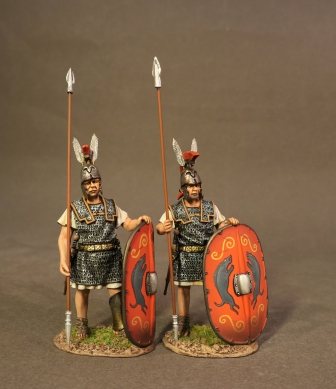
THE ANCIENTS COLLECTION
ARMIES AND ENEMIES OF ANCIENT ROME
TMRR-01R
The Roman Army of The Mid Republic, 2 Triarii, Standing
(2 pcs)
US$89
The Roman Republic was the era of classical Roman civilization
beginning with the overthrow of the Roman Kingdom,
traditionally dated to 509 BC,
and ending in 27 BC with the establishment of the Roman Empire.
It was during this period that Rome's control
expanded from the city's immediate surroundings to hegemony
over the entire Mediterranean world.
Roman government was headed by two consuls,
elected annually by the citizens and advised
by a senate composed of appointed magistrates.
As Roman society was very hierarchical by modern standards,
the evolution of the Roman government was heavily influenced
by the struggle between the patricians,
Rome's land-holding aristocracy,
who traced their ancestry to the founding of Rome, and the plebeians,
the far more numerous citizen-commoners.
Over time, the laws that gave patricians exclusive rights
to Rome's highest offices were repealed or weakened,
and leading plebeian families became full members of the aristocracy.
The leaders of the Republic developed a strong tradition and morality
requiring public service and patronage in peace and war,
making military and political success inextricably linked.
Many of Rome's legal and legislative structures
(later codified into the Justinian Code, and again into the Napoleonic Code)
can still be observed throughout Europe and much of the world
in modern nation states and international organizations.
During the first two centuries of its existence,
the Roman Republic expanded through a combination of conquest and alliance,
from central Italy to the entire Italian peninsula.
By the following century, it included North Africa, most of the Iberian Peninsula,
and what is now southern France.
Two centuries after that,
towards the end of the 1st century BC,
it included the rest of modern France, Greece,
and much of the eastern Mediterranean.
By this time, internal tensions
led to a series of civil wars, culminating with the assassination of Julius Caesar,
which led to the transition from republic to empire.
Historians have variously proposed Julius Caesar's
crossing of the Rubicon River in 49 BC,
Caesar's appointment as dictator for life in 44 BC,
and the defeat of Mark Antony and Cleopatra
at the Battle of Actium in 31 BC.
However, most use the same date as did the ancient Romans themselves,
the Roman Senate's grant of extraordinary powers
to Octavian and his adopting the title Augustus in 27 BC,
as the defining event ending the Republic.
The Roman army of the mid-Republic (also known as the manipular Roman army or the "Polybian army"),
refers to the armed forces deployed by the mid-Roman Republic,
from the end of the Samnite Wars (290 BC) to the end of the Social War (88 BC).
The first phase of this army,
in its manipular structure (290-ca. 130 BC),
is described in detail in the Histories of
the ancient Greek historian Polybius, writing before 146 BC.
The central feature of the mid-Republican army
was the manipular organisation of its battle-line.
Instead of a single, large mass (the phalanx)
as in the Greek and Early Roman army,
the Romans now drew up in three lines (triplex acies)
consisting of small units (maniples) of 120 men,
arrayed in chessboard fashion, giving much greater tactical strength and flexibility.
The Republican army of this period, like its earlier forebear,
did not maintain standing or professional military forces,
but levied them, by compulsory conscription,
as required for each campaigning season and disbanded thereafter
(although formations could be kept in being over winter during major wars).
Service in the legions was limited to property-owning Roman citizens,
normally those known as iuniores (age 16-46).
For the vast majority of the period of its existence,
the Polybian levy was at war.
This led to great strains on Roman and Italian manpower,
but forged a superb fighting machine.
During the Second Punic War, fully two-thirds of
Roman iuniores were under arms continuously.
In the period after the defeat of Carthage in 201 BC,
the army was campaigning exclusively outside Italy,
resulting in its men being away from their home plots of land
for many years at a stretch.
They were assuaged by the large amounts of booty
that they shared after victories in the rich eastern theatre.
But in Italy, the ever-increasing concentration of public
lands in the hands of big landowners,
and the consequent displacement of
the soldiers' families, led to great unrest and demands for land redistribution.
This was successfully achieved, but resulted in the disaffection of
Rome's Italian allies, who as non-citizens were excluded from the redistribution.
This led to the mass revolt of the socii and the Social War (91-88 BC).
The result was the grant of Roman citizenship to all Italians and
the end of the Polybian army's dual structure:
the alae were abolished and the socii recruited into the legions.
The Roman army of the late Republic (88-30 BC) resulted,
a transitional phase to the Imperial Roman army (30 BC - AD 284).
to purchase your figures please send your order by e-mail to
inquiry@johnjenkinsdesigns.com
after checking that everything is available,
you will be billed via PAYPAL.
your order will be shipped on confirmation of payment.
worldwide airmail 15%
(minimum postage us$15)
JOHN JENKINS DESIGNS
UNIT 6E, TOWER 2,
KING LEY INDUSTRIAL BUILDING,
33-35 YIP KAN STREET,
WONG CHUK HANG,
HONG KONG
Tel: 852 9041 9065
